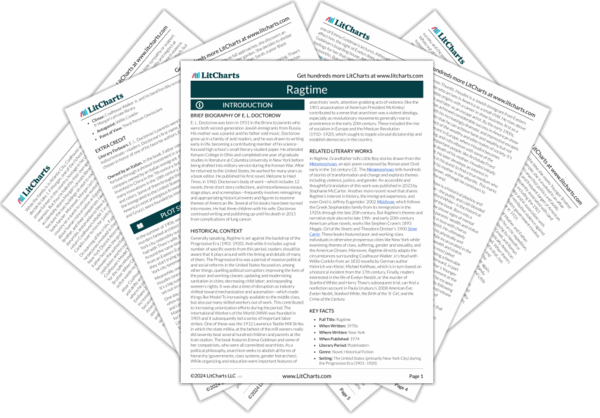In Ragtime, The Model T represents the promise of the American Dream and the failure of American society to follow through on the promises of justice and opportunity it makes to its citizens. Although in one way, the Model T presages the massive upheavals in the American economy brought about by increasing industrialization and automation (one scene has Henry Ford’s backers and employees in tears when his assembly line successfully cranks out one complete car every six minutes), it also signifies the country’s growing prosperity and expanding middle class. The Model T was also the first car inexpensive enough to be available to middle-class individuals. It’s thus telling that this is the kind of car Coalhouse Walker Jr. owns. It visibly telegraphs his comfortable financial status, but it also suggests that this success has a hard limit. As a Black man, he can only rise so far up the social and economic hierarchy.
Because the Model T represents Coalhouse’s successful American Dream, however, it becomes the object of Willie Conklin’s violence. And by displacing his violence from Coalhouse to Coalhouse’s car, the novel makes a bigger point about the fractures and failures of American society. Coalhouse demands and pleads for the authorities to ensure the return of his car—for justice, in other words. But by the time he goes to the authorities, the car is already damaged beyond repair. Then it spends weeks in the bottom of Firehouse Pond, rusting and deteriorating further. When Charles S. Whitman forces Willie Conklin to rebuild the car, it requires a truckful of replacement parts, apparently suggesting that practically no parts of the original remain. The rebuilt, facsimile car confirms promises readers that there a better society can be made, but only insofar as people are willing to abandon the old ways. This echoes ideas espoused by Emma Goldman and her anarchist circle to the effect that some systems are so corrupted that they can’t be modified or improved but must be torn down entirely so that society can rebuild itself in a newer, better, more just and equitable form.
Model T Quotes in Ragtime
There is no question then that Younger Brother was fortunate to conceive a loyalty to the colored man. Standing at the pond he heard the lapping of the water against the front fenders of the Model T. He noted that the hood was unlatched, and lifting and folding it back, saw that the wires had been torn from the engine. The sun was now setting and it threw a reflection of blue sky on the dark water of the pond. There ran through him a small current of rage, perhaps one-hundredth, he knew, of what Coalhouse Walker must have felt, and it was salutary.

Unlock explanations and citation info for this and every other Ragtime quote.
Plus so much more...
Get LitCharts A+But now the authorities were embarrassed. The Ford stood as tangible proof of the Black man’s grievance. Waterlogged and wrecked, it offended the sensibilities of anyone who respected machines and valued what they could do. After its picture was published people began to come see it in such numbers that the police had to cordon off the area. Feeling that they had compromised themselves the Mayor and the Board of Aldermen issued a new series of condemnations of the colored madman and said that to negotiate with him in any way at all, to face him with less than an implacable demand to surrender himself, would be to invite every renegade and radical and black man in the country to flout the law and spit upon the American flag.












